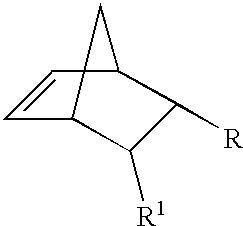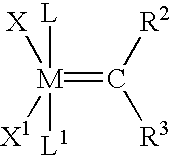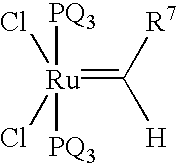Catalyzed reinforced polymer composites
a technology of reinforced polymer and composites, applied in the field of catalytically reinforced polymer composites, can solve the problems of reducing the adhesion between the matrix and the fiber, affecting the performance of the composite, and requiring complex equipment and procedures, so as to reduce the crosslinking density, improve the control, and facilitate the measurement
- Summary
- Abstract
- Description
- Claims
- Application Information
AI Technical Summary
Benefits of technology
Problems solved by technology
Method used
Image
Examples
example 1
Grubbs catalyst (1.2 g) is dissolved in acetone (500 milliliters) and transferred to a spray bottle. Several layers of plain weave e-glass fabric are cut and sprayed with the catalyst solution. The fabric weighs 25 g before the solution application and 26 g after the application once the preform is dry to the touch.
A two-part aluminum-plexiglass mold with an interior of dimensions 3 cm.times.8 cm.times.0.35 cm is used for the RTM process. The lower part of the mould has, on the side at the bottom, an opening of diameter 9 mm connected to the container for the dicyclopentadiene (DCPD) by a channel. A valve is incorporated between the container and the mold. A second opening of diameter 9 mm in the middle of the upper part of the mold is vented to the atmosphere. The preform containing the reactive fibers is laid in the mold. The DCPD (10 g) is transferred into the mold by injecting it through the channel. The flow rate can be regulated by the valve setting. To obtain good impregnatio...
##ic example 1
Prophetic Example 1
A composite bar is made by the process of Example 1, except using Cl.sub.2 (P(C.sub.6 H.sub.5).sub.3).sub.2 Os(.dbd.CH--CH.dbd.C(C.sub.6 H.sub.5).sub.2) as the activator.
##ic example 2
Prophetic Example 2
A composite bar is made by the process of Example 1, except using (F.sub.3 CC(.dbd.O)O).sub.2 (P(C.sub.6 H.sub.5).sub.3).sub.2 Ru(.dbd.CH--CH.dbd.C(C.sub.6 H.sub.5).sub.2) as the activator.
PUM
| Property | Measurement | Unit |
|---|---|---|
| viscosity | aaaaa | aaaaa |
| volume fraction | aaaaa | aaaaa |
| viscosity | aaaaa | aaaaa |
Abstract
Description
Claims
Application Information
 Login to View More
Login to View More - R&D
- Intellectual Property
- Life Sciences
- Materials
- Tech Scout
- Unparalleled Data Quality
- Higher Quality Content
- 60% Fewer Hallucinations
Browse by: Latest US Patents, China's latest patents, Technical Efficacy Thesaurus, Application Domain, Technology Topic, Popular Technical Reports.
© 2025 PatSnap. All rights reserved.Legal|Privacy policy|Modern Slavery Act Transparency Statement|Sitemap|About US| Contact US: help@patsnap.com



